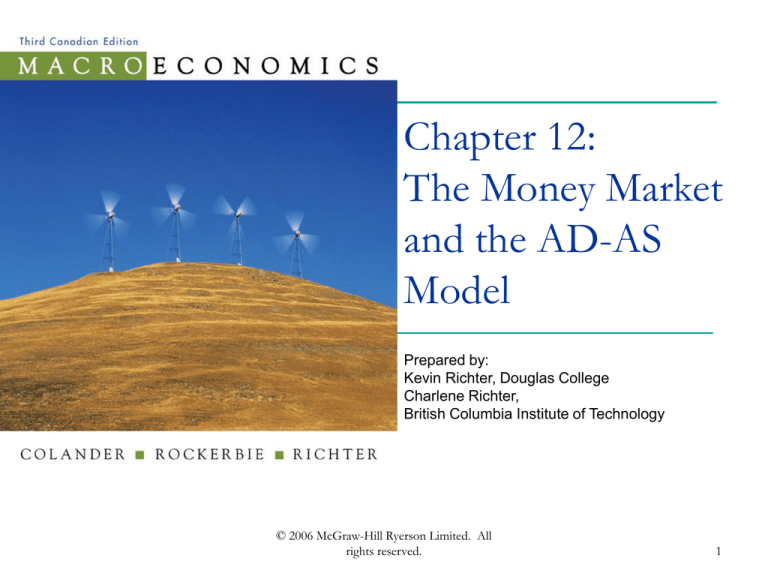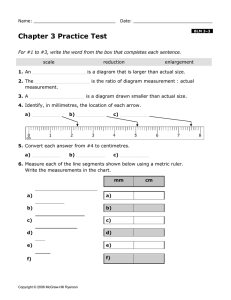
Chapter 12:
The Money Market
and the AD-AS
Model
Prepared by:
Kevin Richter, Douglas College
Charlene Richter,
British Columbia Institute of Technology
© 2006 McGraw-Hill Ryerson Limited. All
rights reserved.
1
Money Market
The money market was not a feature of the
AE or AD-AS models.
Fiscal policies were financed through taxes or
by selling government bonds directly to the
public.
There was no reference to the money market.
© 2006 McGraw-Hill Ryerson Limited. All
rights reserved.
2
Money Market
Without the money market, we cannot
discuss inflation, interest rates, credit
availability, or exchange rate management.
© 2006 McGraw-Hill Ryerson Limited. All
rights reserved.
3
Functions of Money
Money is a medium of exchange.
Money is a unit of account.
Money is a store of wealth.
© 2006 McGraw-Hill Ryerson Limited. All
rights reserved.
4
Money As a Medium of Exchange
Money facilitates exchange by reducing the
cost of trading.
Without money, we would have to barter.
Barter – a direct exchange of goods and
services.
© 2006 McGraw-Hill Ryerson Limited. All
rights reserved.
5
Money As a Medium of Exchange
Money does not have to have any inherent
value to function as a medium of exchange.
All that is necessary is that everyone believes
that other people will exchange it for their
goods.
© 2006 McGraw-Hill Ryerson Limited. All
rights reserved.
6
Money As a Medium of Exchange
The Bank of Canada’s job is to not issue too
much or too little money.
If there is too much money, compared to the
goods and services at existing prices, the
goods and services will sell out, or the prices
will rise.
© 2006 McGraw-Hill Ryerson Limited. All
rights reserved.
7
Money As a Medium of Exchange
If there is too little money, compared to the
goods and services at existing prices, there
will be a shortage of money and people will
have to resort to barter, or prices will fall.
© 2006 McGraw-Hill Ryerson Limited. All
rights reserved.
8
Money As a Unit of Account
Money prices are actually relative prices.
A single unit of account saves our limited
memories and helps us make reasonable
decisions based on relative costs.
© 2006 McGraw-Hill Ryerson Limited. All
rights reserved.
9
Money As a Unit of Account
Money is a useful unit of account only as long
as its value relative to other prices does not
change too quickly.
In a hyperinflation, all prices rise so much
that our frame of reference is lost and money
loses its usefulness as a unit of account.
© 2006 McGraw-Hill Ryerson Limited. All
rights reserved.
10
Money as a Store of Wealth
Money is a financial asset.
As long as money is serving as a medium of
exchange, it automatically also serves as a
store of wealth.
© 2006 McGraw-Hill Ryerson Limited. All
rights reserved.
11
Money as a Store of Value
Money’s usefulness as a store of wealth also
depends upon how well it maintains its value.
Hyperinflations destroy money’s usefulness
as a store of value.
© 2006 McGraw-Hill Ryerson Limited. All
rights reserved.
12
Money as a Store of Wealth
Our ability to spend money for goods makes
it worthwhile to hold money even though it
does not pay interest.
© 2006 McGraw-Hill Ryerson Limited. All
rights reserved.
13
Demand for Money
The demand for money is how much money
people wish to hold as cash.
The money supply is determined by the Bank
of Canada.
The interest rate results from the interaction
of money demand and money supply.
© 2006 McGraw-Hill Ryerson Limited. All
rights reserved.
14
Quantity Theory of Money
Every transaction must have a buyer and a
seller.
Aggregate purchases equal aggregate sales.
© 2006 McGraw-Hill Ryerson Limited. All
rights reserved.
15
Quantity Theory of Money
Total sales equal the number of transactions
(T) times the average price per transaction
(P).
Total sales equals the amount of money in
the economy (M) times the average number
of times it changes hands (V).
Since all transactions are assumed to be paid for
by money.
© 2006 McGraw-Hill Ryerson Limited. All
rights reserved.
16
Quantity Theory of Money
The equation of exchange is an identity:
MV ≡ PT
V is the transaction velocity of money -the average number of times that a dollar is
exchanged between a buyer and a seller in
one year.
© 2006 McGraw-Hill Ryerson Limited. All
rights reserved.
17
Quantity Theory of Money
V is assumed constant
P is measured by the consumer price index.
M is measured as M1, or other measure of
the money stock.
© 2006 McGraw-Hill Ryerson Limited. All
rights reserved.
18
Measuring Transactions
T is more difficult to quantify.
The volume of transactions moves in a stable
proportion to people’s nominal income, P*Y,
so the demand for money is proportional to Y.
© 2006 McGraw-Hill Ryerson Limited. All
rights reserved.
19
Measuring Transactions
We can write the demand for money as
Md = kPY
The k translates the economy’s nominal
income (PY) into nominal money demand.
The k became known as the Cambridge k.
© 2006 McGraw-Hill Ryerson Limited. All
rights reserved.
20
Quantity Theory of Money
The Cambridge k turns the equation of
exchange into a theory of money.
The income velocity of money is the
average number of times a dollar is
exchanged to generate the observed level of
nominal income,
V = PY ÷ M
© 2006 McGraw-Hill Ryerson Limited. All
rights reserved.
21
Income Velocity
Income velocity of money is relatively stable,
but has changed due to:
Financial innovations
automated teller machines
new types of bank accounts
Interest rates
As interest rates rise, we hold our wealth and
income in assets which pay interest.
Money does not pay interest.
© 2006 McGraw-Hill Ryerson Limited. All
rights reserved.
22
Keynesian Approach to Money
Demand
Keynes believed there were three motives for
people to hold money:
Transactions demand
Precautionary demand
Speculative demand
© 2006 McGraw-Hill Ryerson Limited. All
rights reserved.
23
Transactions Demand for Money
The transactions demand for money is
money that is needed to undertake
purchases of goods and services.
It increases with increases in income.
It decreases with frequency of payment
periods.
© 2006 McGraw-Hill Ryerson Limited. All
rights reserved.
24
Precautionary Demand
The precautionary demand for money is
money that is needed to meet unforeseen
expenses.
People hold an amount of money over and
above what is necessary to meet normal
expenses.
© 2006 McGraw-Hill Ryerson Limited. All
rights reserved.
25
Speculative Demand
The speculative demand for money is
money that forms part of an individual’s
portfolio of assets.
Keynes considered a portfolio to be
composed of two types of assets, money and
bonds.
© 2006 McGraw-Hill Ryerson Limited. All
rights reserved.
26
Speculative Demand
Money does not pay interest when held
outside of a bank, but money increases in
value when the price level falls.
Bonds pay interest and may generate a
capital gain when sold.
© 2006 McGraw-Hill Ryerson Limited. All
rights reserved.
27
Secondary Financial Markets
Secondary financial markets encourage
people to own financial assets by providing
liquidity.
Liquidity – the ability to turn an asset into
cash quickly.
© 2006 McGraw-Hill Ryerson Limited. All
rights reserved.
28
Bond Yield
When a bond matures, the holder is paid the
face value of the bond.
The difference between the face value and
the purchase price of the bond is the yield.
It is calculated as a percentage.
© 2006 McGraw-Hill Ryerson Limited. All
rights reserved.
29
Bond Maturity
Maturity refers to the date the issuer must
pay back the money that was borrowed plus
any remaining interest, as agreed when the
asset was issued.
© 2006 McGraw-Hill Ryerson Limited. All
rights reserved.
30
Liquidity Preference
The profit from holding a bond is greater than
the profit from holding money, yet people still
hold money for liquidity purposes.
Liquidity preference is the choice between
holding bonds or money.
© 2006 McGraw-Hill Ryerson Limited. All
rights reserved.
31
Liquidity Preference
Keynes believed individuals formed a
“normal” rate of interest, the rate they
believe rates will return to in normal
conditions.
Everyone has a different value for the normal
rate of interest.
© 2006 McGraw-Hill Ryerson Limited. All
rights reserved.
32
Liquidity Preference
Keynes believed that people’s expectations
regarding interest rates affected their liquidity
preference.
Above the normal rate of interest, people will
choose to invest all of their portfolio in bonds.
Below that rate, people will hold only money.
© 2006 McGraw-Hill Ryerson Limited. All
rights reserved.
33
Liquidity Preference
Money demand is zero above the normal rate
of interest.
As interest rates fall to normal, bond prices
rise, resulting in a capital gain.
Bond prices and interest rates are inversely
related.
© 2006 McGraw-Hill Ryerson Limited. All
rights reserved.
34
Liquidity Preference
The money demand curve is a smooth
downward-sloping function because
everyone has different beliefs about what the
normal rate of interest should be.
There is a negative relationship between the
interest rate and money demanded.
© 2006 McGraw-Hill Ryerson Limited. All
rights reserved.
35
Demand for Money
The demand for money combines the
transactions demand, precautionary demand,
and the speculative demand for money.
© 2006 McGraw-Hill Ryerson Limited. All
rights reserved.
36
Demand for Money
Money demand is a positive function of the
price level and real income.
It is a negative function of the interest rate.
© 2006 McGraw-Hill Ryerson Limited. All
rights reserved.
37
Demand for Money
Money demand is written as
Md = P(Md0 + hY – li)
Md0 is autonomous money demand.
It is the amount of money held if income is zero.
People may have accumulated savings, they may
borrow, or may receive transfer payments.
© 2006 McGraw-Hill Ryerson Limited. All
rights reserved.
38
Demand for Money
Md = P(Md0 + hY – li)
h is the sensitivity of money demand to
changes in real income
l is the sensitivity of money demand to
changes in interest rates
© 2006 McGraw-Hill Ryerson Limited. All
rights reserved.
39
Money Market Equilibrium
To find equilibrium in the money market, we
set money supply equal to money demand,
Md = Ms
This yields the equilibrium interest rate.
© 2006 McGraw-Hill Ryerson Limited. All
rights reserved.
40
Money Market Equilibrium
The interest rate is the opportunity cost of
holding money, since the money could be
placed in an interest-earning asset.
Money earns no interest.
© 2006 McGraw-Hill Ryerson Limited. All
rights reserved.
41
Slope of the Money Demand Curve
The larger the value of l, the more sensitive
money demand is to the interest rate, and the
flatter the money demand curve.
An increase in interest rates will cause
people to move their money holdings into
interest-earning deposits.
© 2006 McGraw-Hill Ryerson Limited. All
rights reserved.
42
Shift of the Money Demand Curve
The money demand curve will shift when real
income or autonomous money demand
changes.
It will shift right when real income rises.
It will shift right if autonomous money
demand rises.
© 2006 McGraw-Hill Ryerson Limited. All
rights reserved.
43
Shift of the Money Demand Curve
Given a fixed money supply, an increase in
money demand will cause equilibrium interest
rate to rise.
A shortage of money causes its price to rise.
The price of money is the interest rate.
© 2006 McGraw-Hill Ryerson Limited. All
rights reserved.
44
From Money Market to AD-AS
The AD curve gives combinations of the price
level and real income where the goods
market and the money market are both in
equilibrium.
It has a negative slope.
© 2006 McGraw-Hill Ryerson Limited. All
rights reserved.
45
From Money Market to AD-AS
Interest rate
Interest rate
Ms/P1
Ms/P0
Investment Demand
i1
i0
MD/P
Money demand
© 2006 McGraw-Hill Ryerson Limited. All
rights reserved.
I1
I0
Real Investment
46
From Money Market to AD-AS
If the price level rises from P0 to P1, real
money supply will decrease.
The existing money supply has lost
purchasing power.
The money supply curve shifts left.
© 2006 McGraw-Hill Ryerson Limited. All
rights reserved.
47
From Money Market to AD-AS
At the existing interest rate, i0, there is an
excess demand for money.
To achieve equilibrium in the money market,
the interest rate must rise.
At an interest rate of i1, the money market
once again is in equilibrium.
© 2006 McGraw-Hill Ryerson Limited. All
rights reserved.
48
From Money Market to AD-AS
As the interest rate rises, it affects the goods
market.
As the interest rate rises, investment projects
are not undertaken where the rate of return is
less than the higher interest rate.
Investment demand falls.
© 2006 McGraw-Hill Ryerson Limited. All
rights reserved.
49
From Money Market to AD-AS
Lower Investment spending lowers
equilibrium real income through the multiplier
process.
This results in a negative relationship
between the price level and real income.
© 2006 McGraw-Hill Ryerson Limited. All
rights reserved.
50
Slope of the AD Curve
The AD curve will be flatter:
the steeper the money demand curve.
l is small
the flatter the Investment demand curve.
the greater the investment multiplier.
© 2006 McGraw-Hill Ryerson Limited. All
rights reserved.
51
Slope of the AD Curve
The AD curve will be steeper,
the flatter the money demand curve.
l is large
the steeper the Investment demand curve.
the smaller the investment multiplier.
© 2006 McGraw-Hill Ryerson Limited. All
rights reserved.
52
Money Neutrality
In the Keynesian approach, changes in the
money market are transmitted to the AD
curve through the interest rate affecting
Investment spending.
Classical economists don’t share this view.
© 2006 McGraw-Hill Ryerson Limited. All
rights reserved.
53
Money Neutrality
The quantity theory suggests that if real
income and velocity are constant, then
changes in the money supply will only affect
the price level.
If money supply were to double, the price
level would also double.
© 2006 McGraw-Hill Ryerson Limited. All
rights reserved.
54
Money Neutrality
This result is known as money neutrality –
changes in the money supply will change
only the price level by the same proportion.
All real variables will be unaffected.
For example, investment spending, consumption
spending, and unemployment.
© 2006 McGraw-Hill Ryerson Limited. All
rights reserved.
55
Money Neutrality
(Patinkin’s) famous helicopter:
If a helicopter were to drop enough cash that
everyone’s money holdings doubled, the
result would be a doubling of prices.
© 2006 McGraw-Hill Ryerson Limited. All
rights reserved.
56
Money Neutrality
The real money demand function is a
demand for purchasing power.
In the long run, real purchasing power is
determined by real variables.
Not by the nominal money supply.
Not by pieces of paper.
© 2006 McGraw-Hill Ryerson Limited. All
rights reserved.
57
Statistical Evidence of the Keynesian
Money Demand Function
Since money supply equals money demand
in equilibrium, economists measure money
demand using the money supply figures.
If the money market is not in equilibrium,
market forces will return the money market to
equilibrium very quickly.
© 2006 McGraw-Hill Ryerson Limited. All
rights reserved.
58
Statistical Evidence of the Keynesian
Money Demand Function
There is a positive relationship between the
Canadian money supply and the consumer
price index.
The relationship is close to one, which
suggest that money neutrality holds for
Canada.
© 2006 McGraw-Hill Ryerson Limited. All
rights reserved.
59
Money Demand Relative to CPI
© 2006 McGraw-Hill Ryerson Limited. All
rights reserved.
60
Statistical Evidence of the Keynesian
Money Demand Function
There is a positive relationship between the
Canadian money supply and real GDP.
The relationship provides support for the
Keynesian money demand function
developed in the chapter.
© 2006 McGraw-Hill Ryerson Limited. All
rights reserved.
61
Money Demand Relative to Real GDP
© 2006 McGraw-Hill Ryerson Limited. All
rights reserved.
62
Statistical Evidence of the Keynesian
Money Demand Function
The relationship between the Canadian
money supply and interest rates is not clear.
There does not seem to be a relationship
between money demand and interest rates.
© 2006 McGraw-Hill Ryerson Limited. All
rights reserved.
63
Money Demand Relative to Interest
Rates
© 2006 McGraw-Hill Ryerson Limited. All
rights reserved.
64
Statistical Evidence of the Keynesian
Money Demand Function
This suggests that the value of l is very close
to zero.
If so, the money demand function is very
steep.
© 2006 McGraw-Hill Ryerson Limited. All
rights reserved.
65
Statistical Evidence of the Keynesian
Money Demand Function
Money demand is not sensitive at all to
changes in interest rates.
This may be due to the various financial
innovations in the 1980s and 1990s.
© 2006 McGraw-Hill Ryerson Limited. All
rights reserved.
66
Statistical Evidence of the Keynesian
Money Demand Function
If money demand is not sensitive at all to
changes in interest rates, then changes in
money supply will have a large impact on
interest rates.
Large changes in interest rates will have a
large impact on investment spending.
© 2006 McGraw-Hill Ryerson Limited. All
rights reserved.
67
Statistical Evidence of the Keynesian
Money Demand Function
In this case, monetary policy – changing the
money supply – will be a very powerful tool
for changing real income.
© 2006 McGraw-Hill Ryerson Limited. All
rights reserved.
68
The Money Market and the
AD-AS Model
End of Chapter 12
© 2006 McGraw-Hill Ryerson Limited. All
rights reserved.
69




